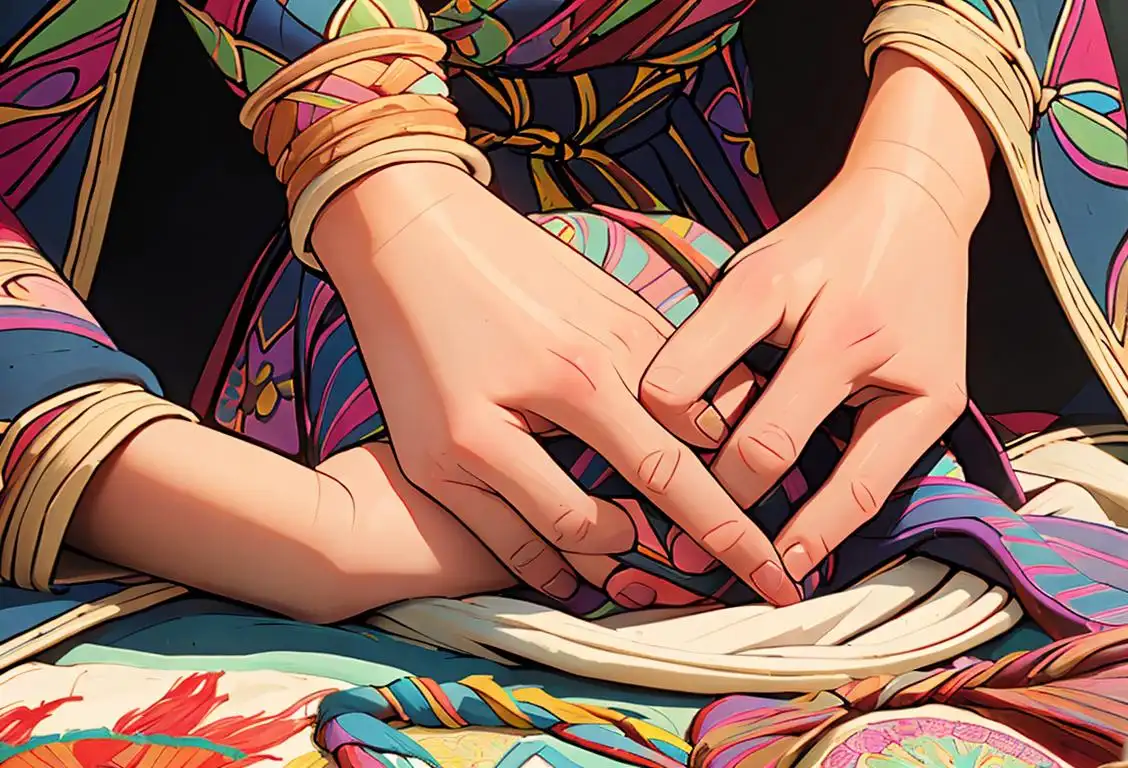National Textiles Day

Hey there, textile enthusiasts! Are you ready to unravel the fascinating world of fabrics? Today is National Textiles Day, a special day dedicated to celebrating the art, science, and history of all things textile-related. So grab your sewing needles, spools of thread, and get ready to dive headfirst into the rich tapestry of textile wonders!
When is Textiles Day?
It's national textiles day on the 3rd May.
The Origins of National Textiles Day
Although we couldn't find detailed information about the origins of National Textiles Day, we can say with absolute certainty that this day was woven into existence to honor the incredible impact textiles have on our lives. From the clothes we wear to the cozy blankets we snuggle up with, textiles are an essential part of our daily existence. So, let's celebrate their versatility and all the crafty wonders that can be achieved with fabric!
A Journey Through Textile History
Textiles have been around for thousands of years, dating back to ancient civilizations such as Egypt, Greece, and China. Back then, the craft of making fabrics was a labor-intensive process involving spinning fibers (such as cotton, wool, and silk) into threads and weaving them together to create cloth.
Over the centuries, textile production techniques evolved, leading to the invention of the spinning wheel and later the power loom during the Industrial Revolution. These innovations revolutionized the textile industry, making fabric production faster and more efficient.
From simple linens to intricate tapestries, textiles have always played a significant role in defining cultures and expressing individuality. Traditional garments, such as kimono in Japan or tartan kilts in Scotland, showcase the unique aesthetic and craftsmanship of different regions.
The Modern World of Textiles
In today's world, textiles have expanded beyond clothing and home décor. Technological advancements have led to the creation of specialized textiles with unique properties. Have you heard of moisture-wicking athletic wear? Or fire-resistant fabrics used in certain professions? Yep, those are just a few examples of how textiles have adapted to our evolving needs.
And let's not forget the exciting world of fashion! From the runways of Paris to the local boutique near you, textiles take center stage in the creation of stunning garments. Designers experiment with different fabrics, patterns, and textures to bring their creative visions to life.
Get Crafty on National Textiles Day
What better way to celebrate National Textiles Day than getting your craft on? Whether you're an experienced seamstress or just starting to thread your first needle, everyone can enjoy the wonders of textile crafts. Here are a few ideas to inspire you:
- Create your own embroidered masterpiece
- Sew a unique garment or accessory
- Try your hand at quilting or knitting
- Experiment with tie-dye or fabric painting
Remember, it's all about embracing your inner creativity and having fun with textiles!
History behind the term 'Textiles'
30000 BCE
Primitive beginnings
Evidence of the earliest form of textile production dates back to around 30,000 BCE during the Paleolithic era. In ancient times, people would make simple textiles by twisting together fibers from plants, such as flax, hemp, or nettle, to create rudimentary fabrics for clothing and shelter.
5000 BCE
Earliest Known Use of Textiles
Textiles have been a part of human civilization for thousands of years. The earliest known use of textiles dates back to around 5000 BCE in ancient Egypt and the Indus Valley civilization. People in these regions began weaving fibers from plant stems, such as flax and cotton, into basic fabrics for clothing and other purposes.
3000 BCE
Ancient Beginnings
Textiles have a rich history that dates back to around 3000 BCE. The term 'textiles' refers to materials woven or knitted together to create fabrics or clothing. In ancient times, people would use materials such as animal hides, plant fibers, and even natural grasses to create basic textiles. These early fabrics were typically rudimentary and served mainly functional purposes.
4000 BC
Early Beginnings
Textiles have a long and fascinating history that begins around 4000 BC. The earliest evidence of textiles comes from ancient civilizations in Egypt and Mesopotamia. At this time, people would make fabrics using natural materials such as flax, wool, and silk. Textiles played a crucial role in daily life, providing clothing, shelter, and even status symbols for the societies.
6500 BCE
Early Beginnings
Textiles have their roots in the early human civilization, dating back to around 6500 BCE. Archaeological evidence suggests that ancient civilizations began weaving fibers together to create basic forms of fabrics. This development was a crucial step in human history, as it marked the beginning of textile production and usage.
2700 BCE
The Ancient Beginnings
Textiles have a rich history dating back to ancient civilizations. The ancient Egyptians were renowned for their advanced textile craftsmanship. They used various materials such as flax and wool to create fabrics for clothing, household items, and burial shrouds. Weaving and spinning techniques developed during this time laid the foundation for the textile industry.
3000 BCE
The Wheel and Loom
Around 3000 BCE, the invention of the wheel and the development of vertical looms revolutionized textile production. The wheel allowed for the creation of spinning devices, which made the process of turning fibers into yarn more efficient. Additionally, vertical looms provided a stable platform for weaving the yarn into textiles, enabling the production of larger and more complex fabrics.
5000 BCE
Spinning techniques
Around 5,000 BCE, an essential innovation known as spinning was developed. Spinning involved drawing out fibers and twisting them to form thread or yarn. Spindles made from materials like wood or ceramic were used to spin fibers into a more refined and usable form, opening up possibilities for more intricate textile designs.
5500 BC
Flax Cultivation
During the Neolithic period, around 5500 BC, humans began cultivating flax, a plant known for its strong fibers. Flax fibers were spun into yarns, which were then woven into linen fabrics. Linen became a highly valued textile due to its durability, breathability, and ability to be extensively washed.
1000 BCE
Advancements in Spinning and Weaving
Around 1000 BCE, significant advancements in spinning and weaving techniques took place in various parts of the world. In ancient India, the spinning wheel was invented, revolutionizing textile production. The Greeks and Romans also made notable contributions to textile technology, introducing the horizontal loom and improving the dyeing process.
500 BCE
Early Innovations
By 500 BCE, textiles had become more sophisticated, thanks to advancements in weaving techniques and the introduction of new materials. In regions like Ancient Greece and Egypt, people utilized looms to create intricate patterns and designs in their fabrics. Silk, a highly prized material, was also introduced during this period, with the Chinese being the first to cultivate silk worms and produce silk threads.
14th Century
Renaissance of Textile Trade
The 14th century marked a significant period in the history of textiles. With the rise of trade routes, luxurious and intricately woven fabrics like silk, velvet, and brocade gained popularity. Cities like Florence and Venice became major centers of textile production and trade, exporting their products throughout Europe and beyond. The demand for textiles fueled economic growth and cultural exchange.
12th Century
Medieval European Guilds
During the 12th century, textile production became organized within guild systems in Medieval Europe. Guilds were associations of skilled craftsmen who regulated and protected their trades. Textile guilds played a vital role in maintaining quality standards, training apprentices, and preserving traditional techniques, contributing to the growth of the textile industry.
18th Century
Industrial Revolution Transforms Textiles
The Industrial Revolution brought revolutionary advancements to the textile industry. The development of textile machinery, such as the spinning jenny and power loom, transformed the production process. With these inventions, textiles could be mass-produced on a larger scale, leading to increased efficiency and availability. This period marked a shift from handcrafted textiles to mechanized production methods.
2696 BC
Silk Discovery
In 2696 BC, according to Chinese legend, the Empress Leizu discovered silk while sipping tea under a mulberry tree. A cocoon fell into her cup, and she observed the silk thread unraveling. Fascinated, she began sericulture, the cultivation of silkworms and the production of silk. Silk quickly became a highly sought-after luxury textile, with China dominating its production and trade for centuries to come.
550 BCE
Silk Road and Trade
In 550 BCE, the Silk Road was established, connecting China with the Western world. This ancient trade route facilitated the spread of silk and other luxurious textiles to different regions. The demand for these fine fabrics grew immensely, leading to the establishment of flourishing textile industries in many countries along the Silk Road.
4000 BCE
Weaving emerges
Weaving, the process of interlacing two distinct sets of yarn or thread, was established around 4,000 BCE. This technique allowed for the creation of more complex and durable textiles. Primitive looms were fashioned to facilitate the weaving process, enabling the production of various fabric patterns and designs.
Middle Ages (5th-15th century)
Textile Trade Flourishes
During the Middle Ages, the textile industry began to flourish, particularly in Europe. Countries like Italy, Flanders (Belgium), and England became renowned for their textile production. Wool was the most commonly used material, and guilds were established to regulate the industry. Textile trade routes, such as the Silk Road, played a significant role in the exchange of knowledge and materials, leading to further advancements in textile manufacturing and design.
20th Century
Modern Textile Innovations
In the 20th century, textile innovations continued to shape the industry. Synthetic fibers such as nylon and polyester were introduced, offering new possibilities in terms of durability and performance. The development of textile technologies like computerized looms revolutionized the manufacturing process. Textiles became integral parts of various industries, including fashion, interior design, and aerospace.
12th Century
Rise of European Textile Industry
During the 12th century, Europe witnessed a significant rise in textile production. Manufacturing centers like Flanders and Italy became renowned for their high-quality fabrics such as wool, linen, and later cotton. The European textile industry played a crucial role in shaping the region's economy and trade with other nations.
18th Century
Industrial Revolution and Textile Mills
The 18th century witnessed a pivotal moment in textile history with the advent of the Industrial Revolution. Textile production underwent a massive transformation as manual labor gave way to mechanization. Textile mills emerged as centers of mass production, powered by water and steam engines. This period marked a significant increase in textile output and accessibility.
2800 BCE
Early dyeing techniques
The art of dyeing textiles originated around 2,800 BCE in ancient Egypt. Ancient dyers employed natural substances such as plants, minerals, and insects to imbue fabrics with vibrant colors. Dyes were extracted by crushing and boiling the source material and then soaking the fibers in the resulting dye baths to achieve desired hues.
18th Century
Industrial Revolution
The 18th century marked a pivotal moment in the history of textiles with the advent of the Industrial Revolution. Various inventions, including spinning machines and power looms, revolutionized the industry. New materials like cotton gained popularity, and mass production became possible. This era saw the rise of textile factories and the mechanization of textile production, leading to increased accessibility and affordability of fabrics.
1000 AD
Spinning Wheel Revolution
The advent of the spinning wheel in the 11th century revolutionized textile production. Prior to this invention, fibers were spun into yarn using drop spindles, a slow and labor-intensive process. With the spinning wheel, yarn production became faster and more efficient, enabling the textile industry to flourish.
1733 CE
Industrial revolution spurs innovation
The Industrial Revolution in the 18th century revolutionized textile production. In 1733, John Kay invented the flying shuttle, a mechanized device that made weaving faster and more efficient. Subsequent inventions, including the spinning jenny and the power loom, further propelled the growth of the textile industry, leading to mass production and increased accessibility of textiles.
1764
Industrial Revolution and Cotton
The Industrial Revolution in the 18th century brought significant advancements in textile manufacturing. In 1764, James Hargreaves invented the spinning jenny, a machine that could spin multiple threads simultaneously. This innovation, along with later inventions like the power loom, revolutionized the production of cotton textiles, making them more affordable and accessible to a larger population.
20th Century
Technological Advancements
In the 20th century, the textile industry witnessed significant technological advancements. Synthetic fibers such as nylon and polyester were developed, offering new possibilities in terms of durability and performance. Textile mills became highly automated, employing modern machinery and techniques. The rise of fashion and couture further propelled the demand and innovation in textiles, with designers experimenting with new materials and creating iconic fabrics.
19th Century
Invention of Synthetic Fibers
In the 19th century, the textile industry witnessed another substantial advancement: the invention of synthetic fibers. British scientist Sir Joseph Swan developed the first artificial silk in 1884, followed by the invention of rayon in the late 19th century. These synthetic fibers provided alternative materials that expanded textile possibilities and diversified fabric choices.
18th Century
Industrial Revolution and Mechanization
The 18th century marked the beginning of the Industrial Revolution, which had a profound impact on textile production. Innovations like the spinning jenny, water frame, and power loom transformed the industry by introducing mechanization. These advancements significantly increased the speed and efficiency of textile manufacturing, leading to a surge in mass production.
Present
Textiles in the Digital Age
In the present day, textiles continue to evolve alongside technological advancements. Smart textiles, embedded with sensors and electronics, are being developed for applications like healthcare, sports, and wearable technology. Sustainable and eco-friendly textile production methods are gaining importance, addressing concerns about environmental impact. The global textile industry remains a significant contributor to economies worldwide, intertwining tradition, innovation, and cultural expression.
20th Century
Textile Innovations and Fashion Revolution
The 20th century saw numerous textile innovations and the rise of the fashion industry. Nylon, a versatile and durable synthetic fiber, was introduced in the 1930s, enabling the production of affordable stockings. Later, advancements in technology led to the development of fabrics like spandex, polyester, and microfiber, revolutionizing clothing comfort and performance.
20th Century
Synthetic Fibers and Technological Advancements
In the 20th century, technological advancements revolutionized the textile industry once again. Synthetic fibers such as nylon and polyester were developed, providing new possibilities for fabric production. Moreover, innovations in dyeing techniques, printing methods, and textile machinery further expanded the range of designs and patterns.
1920s
Synthetic Fibers Emergence
The early 20th century witnessed the emergence of synthetic fibers, marking a new era in textile history. In the 1920s, materials like rayon and nylon were developed, offering alternative options to natural fibers. Synthetic fibers provided unique properties, including strength, durability, and resistance to wrinkles, opening up new possibilities for fashion and industrial applications.
Present Day
Textiles in the Modern World
In the present day, textiles continue to be an essential part of our lives. They are no longer limited to clothing but also find applications in interior design, automotive industry, medical field, and more. Sustainable and eco-friendly textiles have gained prominence, promoting ethical and responsible practices in the industry. Textile innovations, such as smart fabrics embedded with technology, are also shaping the future of textiles, offering functionalities like temperature regulation or antimicrobial properties.
20th century
Synthetic fibers revolutionize the industry
The 20th century witnessed significant advancements in textile manufacturing with the development of synthetic fibers. Nylon, the first synthetic fiber, was created in 1935, followed by other groundbreaking materials like polyester and acrylic. These synthetic fibers offered improved durability, wrinkle resistance, and enhanced performance in various applications.
Did you know?
Did you know that the world's oldest known textile, a piece of linen, was found in a cave in the Republic of Georgia and is estimated to be over 34,000 years old? Talk about a timeless fashion statement!Tagged
fun fashion craftsFirst identified
3rd May 2017Most mentioned on
3rd May 2017Total mentions
45Other days
Textiles Day
Socks Day
Tassel Day
Pom Day
Ugly Christmas Sweater Day
Bow Tie Day
Batik Day
Nail Polish Day
Hijab Day
Hat Day








